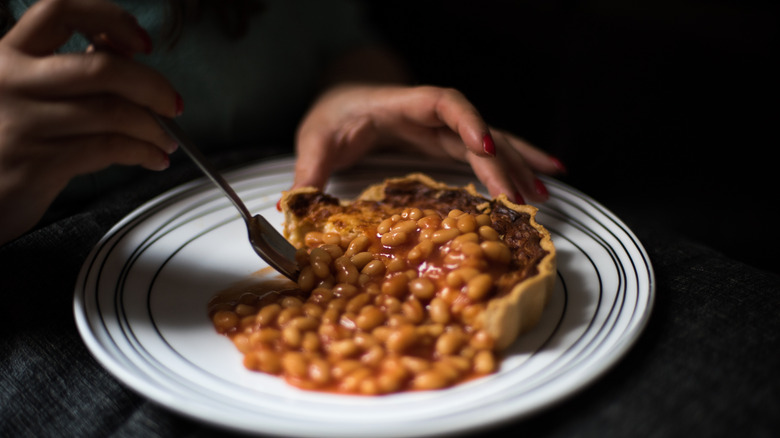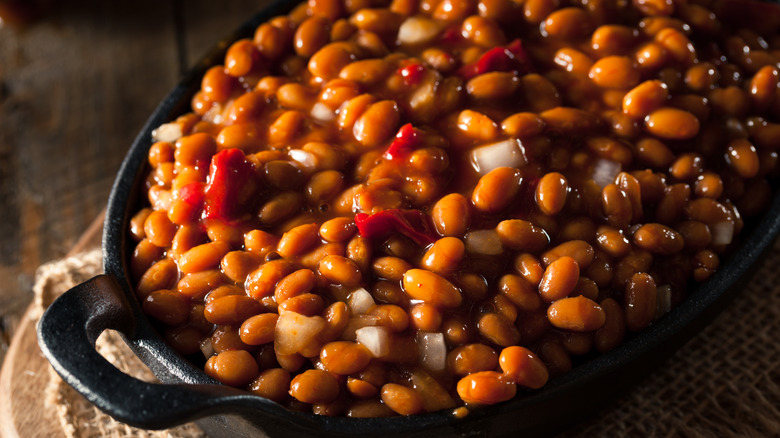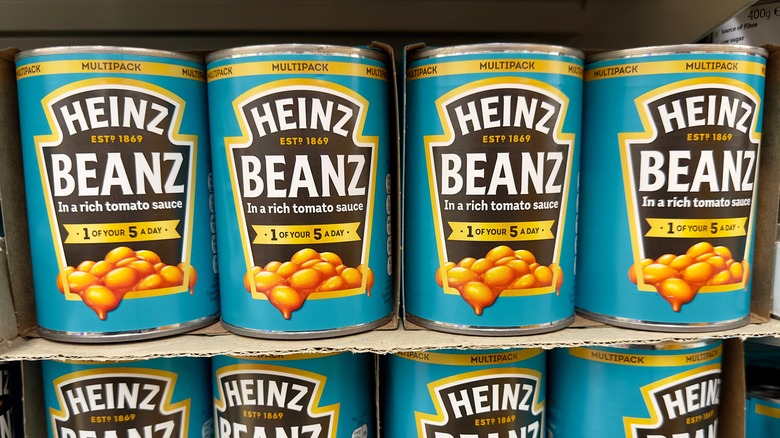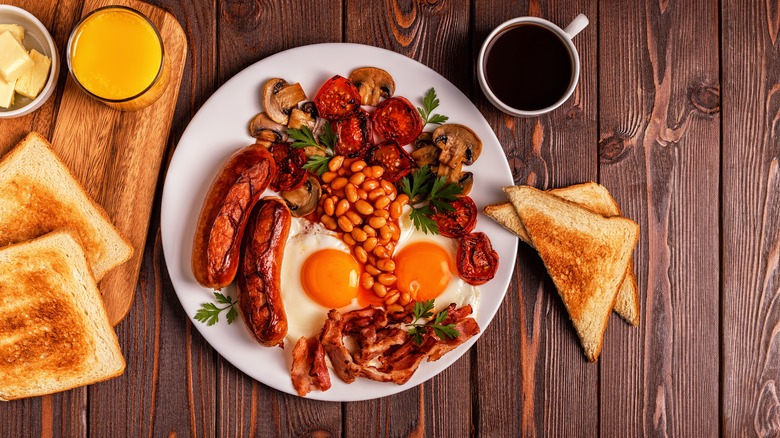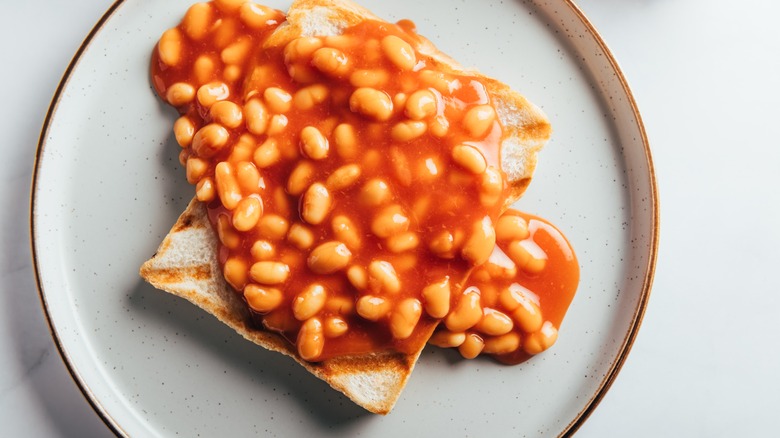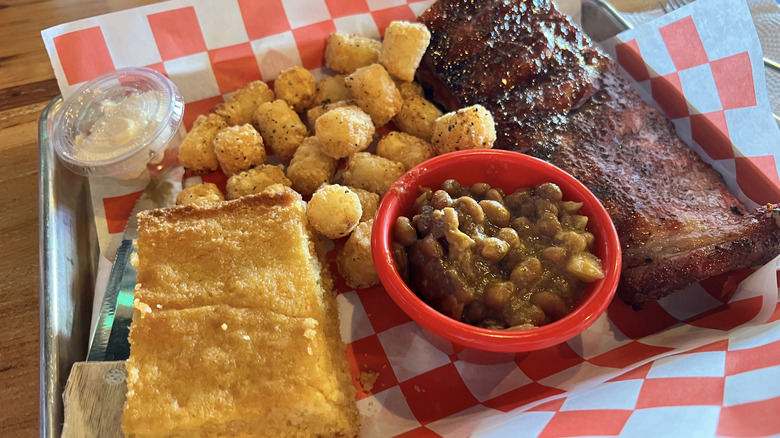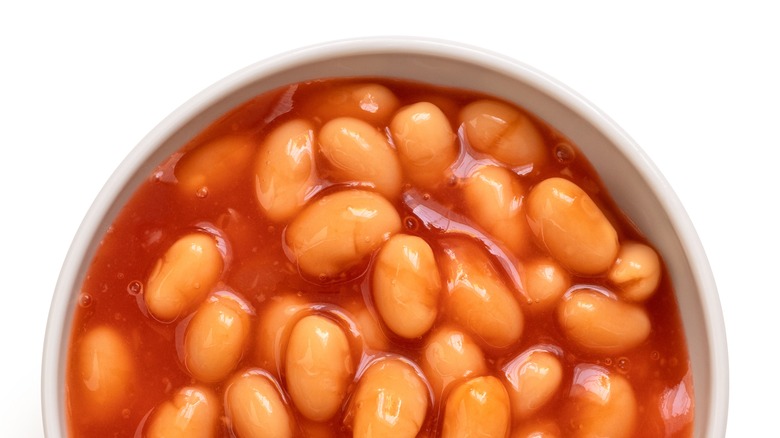British Vs American Baked Beans: The Differences Between Them And Other Things You Need To Know
America and Great Britain aren't just two countries divided by a common language — they're also two countries divided by a common dish. Baked beans are beloved on both sides of the pond, but just like the language, there are quite a few differences between the styles beloved in London and Los Angeles.
Unlike the English language, baked beans got their start in America, a traditional recipe mass-produced for the first time by the HJ Heinz Company in 1895. Henry Heinz wouldn't launch his baked beans in the UK until 1901, when the product surged in popularity, particularly in times of austerity during World War II. These days, Brits are way bigger fans of baked beans than Americans: More baked beans are eaten by Brits than anyone else in the world, with 100.9 metric tons of baked beans imported into Britain each year, according to Tridge.
To learn more about these differences, we interviewed Stephen Palacios, Senior Vice President of Marketing & Innovation at Bush's. Here are the major differences you can expect, depending on where you're eating them.
American baked beans are sweeter than British baked beans
One of the biggest differences between American and British baked beans is their flavor, according to Stephen Palacios. "American baked beans tend to have a richer, sweeter flavor perfect for the barbecuing occasions," he says. "Whereas British baked beans are primarily tomato-based sauces and less sweet."
The sweetness of American baked beans comes down to the addition of molasses, a traditional ingredient beloved particularly in New England, which gives the bean sauce a far deeper, brownish hue and a barbecue sauce flavor, as compared to the plain tomato sauce Brits go for, which some say tastes more like ketchup. Americans in Britain may even find British beans "bland," if suggestions on Quora are any indication. Home cooks claim they need to doctor British beans with ketchup, mustard, hot sauce, bacon, onion, spices, and, of course, molasses to them to make them palatable.
British baked beans are usually vegetarian
Most American baked beans get a lot of their flavor from the addition of pork, whether it's bacon, salt pork, or sausage. This tradition dates back centuries to when a small amount of meat needed stretching to fill a whole household. Using a bit of salt pork to flavor a whole pot of beans ensured everyone got a taste of meat, while the far cheaper beans did the work of filling all those hungry bellies. Even now that access to meat is more democratized, most American baked bean companies, like Bush's, continue to add meat to their recipes.
But the beans most popular in the U.K. are devoid of any pork fat whatsoever, a holdover from World War II-era rationing when meat was far harder to come by. Since then, however, the meat has remained outside of the can. This is just one reflection of the ways in which vegetarian and vegan options are so popular and widespread in the U.K., especially as compared to America.
British baked beans are a breakfast food
Another major difference between baked beans in the U.S. and the U.K. is when they're eaten. In Britain, baked beans "are classically known as a breakfast staple, served on toast to start the day," according to Stephen Palacios. Indeed, baked beans are a big part of a traditional full English breakfast, which sees them served alongside eggs, bacon, sausage, grilled tomatoes, mushrooms, and toast.
But baked beans can also be part of a far more demure English-style breakfast. According to Chef Darren McGrady, Princess Diana's former private chef, the princess' favorite breakfast was a can of Heinz baked beans, which, he tells Business Insider, she would eat at least three times a week, alongside grapefruit, coffee, and orange juice. They can also be paired with fried eggs, feta cheese, avocado, or scrambled eggs and toast for a protein-rich way to start your day.
British baked beans are at home on a baked potato, on toast, or on a potato waffle
But Brits don't just eat baked beans first thing in the morning. "Beans on toast" is a popular lunch or dinner option on nights when Brits just don't have time to make anything more complicated. In fact, food historian Rachel Laudan posits to the Economist that the whole reason baked beans became so popular in Britain in the first place is because of a pre-existing British love for the category of the "on-toast meal." The simple pairing of beans and white toast, the latter perhaps spread with butter and yeasty Marmite, has since become a comfort food staple par excellence — one that surged in popularity during Covid, when its lack of expense and ease of preparation made it a no-brainer for busy parents trying to work from home.
But toast is only one acceptable vehicle for British baked beans. Brits also pile them on top of potatoes in the form of potato waffles or jacket potatoes, aka baked potatoes. In either case, a handful of grated sharp cheddar is a welcome addition, as is a shake of Tabasco sauce for those who like things a bit on the spicier side.
American baked beans are a side dish
In stark contrast to the British approach, Americans rarely see baked beans as the star of the show. Instead, according to Palacios, "they more commonly accompany cookouts and grilling occasions," sharing the spotlight with meatier choices. "You'll find Bush's Baked Beans served as a delicious side to hot dogs and hamburgers at a backyard cookout, gameday tailgate, or even a campfire meal," he says. And that's not all.
In central California, you'll find baked beans served alongside tri-tip steak. In the South, pit-style baked beans are served alongside slow-cooked barbecue specialties, and some baked beans may even be seasoned with burnt ends, a delicious byproduct of slow-smoked brisket. Perhaps the closest American calque to the comfort and ease with which the Brits dig into beans on toast is the New England tradition of "franks and beans," whereby a slow-cooked pot of New England baked beans is served on buttered buns or New England brown bread. But even this recipe gives beans a secondary role, the very name of the dish turning attention to the headlining "franks."
American baked beans vary widely from region to region
Baked beans don't just differ between America and Britain. Within the U.S., loads of regional variants of baked beans exist. In the Northeast, Maine, and Boston baked beans typically begin with small white beans that are sweetened with molasses and simmered with pork. But in the Southwest, baked beans have a tendency to be savory and spicy, relying on local pinto or black beans instead of white navy. In the South, baked beans could take advantage of the kick of mustard; in California, local pinquito beans are often simmered with local chiles. And with so many regional varieties and recipes, it's no surprise that so many American cooks make their own baked beans, either from dried beans or beginning with a can of unseasoned cooked beans.
In the U.K., meanwhile, one bean rules supreme. The original Heinz brand of baked beans is by far the favorite among Brits, representing about 60% of the total baked beans bought in British shops. The northern English Heinz factory produces a whopping 3 million cans of beans each day, making it the largest food-processing plant in Europe.
